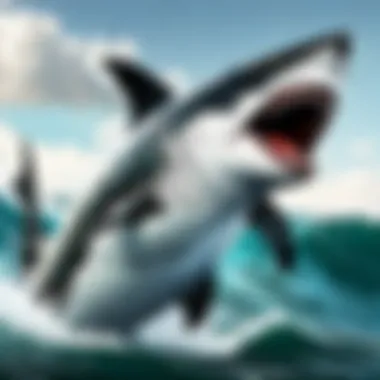Exploring the Potential Predators of the Great White Shark in the Marine Realm


Predators of the Great White Shark
When diving into the realm of the great white shark, one cannot help but wonder - does this formidable apex predator face any rivals in its watery domain? In this article, we embark on a journey to unveil the potential predators that dare to challenge the supremacy of the great white shark. By exploring the intricate dynamics of the marine ecosystem, we aim to shed light on the various forces that shape the fate of this majestic creature.
The Myth of Invincibility
The great white shark, with its sheer size, razor-sharp teeth, and unmatched hunting prowess, has long been hailed as the ruler of the ocean. However, lurking beneath the surface lies a myriad of potential threats that serve as a constant reminder of the vulnerability of even the most fearsome predator. From orcas to larger sharks and even parasites, the great white shark navigates a perilous world where survival hinges on a delicate balance of power and cunning.
Orca: The Ocean's Apex Predator
Among the most formidable adversaries of the great white shark is the orca, also known as the killer whale. With its intelligence, social structure, and cooperative hunting tactics, the orca poses a significant challenge to the solitary nature of the great white shark. In the battle for supremacy, the orca has been observed preying on great white sharks with remarkable efficiency, showcasing a level of strategic prowess that surpasses mere brute strength.
Apex Predators Collide: Great White vs. Killer Whale
The encounter between a great white shark and an orca is a tantalizing clash of titans, where two apex predators vie for dominance in the unforgiving seas. The swift agility of the orca, coupled with its ability to deliver precise and coordinated attacks, often puts the great white shark at a strategic disadvantage. As we delve into the dramatic realm of predator-prey interactions, the age-old question of who emerges victorious in these epic battles unveils a complex tapestry of survival strategies and evolutionary adaptations.
Balancing Act: Surviving in a Predator's World
For the great white shark, navigating a world teeming with potential predators requires a keen sense of awareness, adaptation, and resilience. From honing its predatory techniques to leveraging its environment for strategic advantage, the great white shark embodies the intricate dance of survival in a realm where every encounter could mean the difference between dominance and defeat. By unraveling the enigmatic world of the great white shark's predators, we gain profound insights into the delicate equilibrium that sustains life in the vast blue expanse of the ocean.
Introduction
In the vast expanse of the marine ecosystem, the Great White Shark reigns supreme as an apex predator, instilling both fear and fascination among researchers and enthusiasts alike. This article serves as a comprehensive exploration into the intricate predator-prey dynamics surrounding this majestic creature. By delving into the realm of the Great White Shark's predators, adaptations, and its vital ecological role within the oceanic food chain, we aim to shed light on the enigmatic world of this formidable predator.
Understanding the Great White Shark
Physical Characteristics


The physical characteristics of the Great White Shark play a pivotal role in its predatory prowess. With its sleek, torpedo-shaped body and rows of razor-sharp teeth, the Great White Shark embodies the quintessential image of a fearsome marine predator. Its remarkable speed and agility, coupled with its keen sense of smell and excellent vision, make it a formidable hunter in the depths of the ocean. These physical traits not only contribute to the Great White Shark's predatory success but also underline its significance as a top-tier predator in marine ecosystems.
Behavioral Traits
The behavioral traits of the Great White Shark offer further insight into its exceptional predatory capabilities. Known for its stealthy hunting tactics and strategic approach to prey capture, the Great White Shark exhibits a complex interplay of instincts and learned behavior. From displaying patience during ambush predation to engaging in cooperative group hunting, this apex predator demonstrates a remarkable level of intelligence and adaptability in its pursuit of food. These behavioral traits underscore the Great White Shark's unparalleled position at the apex of the food chain.
Ecological Significance
Beyond its role as a formidable predator, the Great White Shark holds immense ecological significance within marine ecosystems. As a keystone species, the presence of the Great White Shark exerts a cascading influence on the populations of its prey species, helping to regulate balance and prevent overpopulation. By maintaining the diversity and health of marine communities, the Great White Shark contributes to the resilience and stability of the entire ecosystem.
Significance of Predators in Ecosystems
Role of Predators in Maintaining Balance
Predators play a critical role in maintaining ecological balance within diverse ecosystems. By controlling the populations of prey species, predators help prevent unchecked growth and promote biodiversity. The presence of predators like the Great White Shark serves as a natural regulator, ensuring that ecosystems remain in harmony and functions effectively. The intricate interplay between predators and prey highlights the delicate balance that sustains life within marine environments.
Impact of Predator Loss
The loss of predators can have profound consequences on ecosystem dynamics, leading to complex ecological disruptions. When predator populations decline or disappear, prey species may experience unchecked growth, causing imbalances that ripple throughout the food chain. The absence of top predators like the Great White Shark can trigger chain reactions that disturb the structure and function of entire ecosystems, highlighting the interconnected nature of life forms in the wild.
Purpose of the Study
Exploring Predation Dynamics of Great White Sharks
The study aims to unravel the intricate predation dynamics surrounding Great White Sharks, delving deep into their hunting behaviors, interactions with prey, and ecological impacts. By examining the predatory strategies employed by these apex predators, researchers seek to gain a deeper understanding of how Great White Sharks shape marine ecosystems. Through behavioral studies and conservation efforts, this exploration aims to enhance our knowledge of these majestic creatures and inform conservation strategies for their protection and preservation.
Predator-Prey Dynamics


In this section, we delve into the intricate balance of predator-prey dynamics surrounding the formidable Great White Shark. Understanding the dynamics between predators and their prey is crucial in deciphering the role of the Great White Shark in its ecosystem. By examining how predators interact with this apex predator, we can gain valuable insights into the hierarchical structure of marine food chains and the delicate equilibrium that exists within oceanic environments.
Natural Predators of the Great White Shark
- Killer Whales: At the top of the list of natural predators are Killer Whales, also known as orcas. These marine mammals are highly intelligent and skilled hunters, with a diverse diet that sometimes includes Great White Sharks. The adaptability and collaborative hunting techniques of Killer Whales make them formidable predators in the oceanic realm.
- Large Sharks: Large Sharks, such as the Tiger Shark and the Great Hammerhead Shark, pose a threat to Great White Sharks due to their size and strength. With powerful jaws and an adept ability to navigate vast ocean territories, large sharks present a significant predatory challenge to Great Whites.
- Orcas: Orcas, commonly referred to as killer whales, exhibit complex social structures and cooperative hunting behaviors that make them effective predators against Great White Sharks. Their strategic approach to hunting and communication within pods enables them to target and overpower even the most substantial marine creatures.
Predatory Strategies Against Great White Sharks
Exploring the predatory strategies employed against Great White Sharks sheds light on the dynamic tactics utilized by other marine predators. Ambush predation, involving sudden and stealthy attacks, serves as a strategic way for predators to surprise their prey. Group hunting, a coordinated effort among predators, maximizes the chances of success in capturing elusive targets such as Great White Sharks. Furthermore, the utilization of strengths, where predators leverage their unique abilities to gain an upper hand, showcases the complexity and adaptability of marine predators in their pursuit of prey.
Adaptations and Defenses of Great Whites
Examining the adaptations and defenses of Great White Sharks unveils the evolutionary marvels that enable them to survive in challenging oceanic environments. Camouflage techniques, including counter-shading and disruptive coloration, help Great Whites blend into their surroundings and effectively stalk their prey. Their remarkable speed and agility allow them to outmaneuver potential predators and swiftly capture prey. Additionally, the physiological resilience of Great White Sharks, characterized by their exceptional healing abilities and keen sensory perception, equips them with the tools necessary to thrive as apex predators in marine ecosystems.
Ecological Implications
In this comprehensive article shedding light on the natural dynamics of the marine world, the section on Ecological Implications holds paramount importance. It intricately dissects the significance of how predator-prey relationships, specifically the impact of the Great White Shark, cascade through ecosystems. Understanding the delicate balance between predator and prey is essential to assessing the ecological health of marine habitats. By exploring how the Great White Shark influences prey populations and ecosystem diversity, we gain insight into the intricate web of life beneath the waves.
Impact of Great White Shark Predation
Regulation of Prey Populations
This segment delves into the critical role of the Great White Shark in regulating prey populations. The meticulous regulation exercised by these apex predators ensures that prey species do not overpopulate, which can have cascading effects on the entire ecosystem. The methodical control of prey numbers by the Great White Shark helps maintain equilibrium in the marine food chain, showcasing its pivotal importance in sustaining the delicate balance of oceanic biodiversity. Despite the necessity of this regulation, it also poses challenges, such as potential shifts in prey distributions. Overall, the regulatory function of the Great White Shark on prey populations underscores its indispensable role within marine ecosystems.
Diversity Preservation in Ecosystems
Exploring the Great White Shark's impact on diversity preservation uncovers a cornerstone of ecological stability. By preying on a diverse range of species, this apex predator helps sustain ecosystem richness. The Great White Shark's selective predation keeps various populations in check, preventing the dominance of any single species and fostering a balanced ecosystem. This diversity preservation not only bolsters the resilience of marine communities but also safeguards against potential ecological imbalances. However, this ecological service comes with the challenge of adapting to changing prey availability and environmental conditions, highlighting the intricate interplay between predator and prey in preserving ecosystem diversity.


Interactions with Human Activities
Fisheries and Trophic Cascades
The intricate dance between the Great White Shark and human activities, particularly in fisheries and trophic cascades, sheds light on the complex relationship between apex predators and anthropogenic influences. Fisheries targeting species within the Great White Shark's diet can disrupt predator-prey dynamics, leading to ripple effects throughout the food chain. Trophic cascades triggered by overfishing can destabilize marine ecosystems, underscoring the need for sustainable fishing practices and ecosystem-based management to mitigate adverse impacts. Balancing economic interests with ecological conservation presents a multifaceted challenge, highlighting the delicate equilibrium required to harmonize human activities with nature.
Conservation Efforts
The section on Conservation Efforts delves into the proactive measures taken to safeguard the Great White Shark and its habitats. Amidst escalating anthropogenic pressures, conservation initiatives play a pivotal role in preserving apex predators and maintaining marine ecosystem health. From habitat protection to responsible tourism practices, conservation efforts aim to ensure the long-term viability of Great White Shark populations while promoting coexistence with human activities. However, the implementation of conservation strategies faces hurdles such as regulatory gaps and resource limitations, necessitating collaborative efforts from governments, stakeholders, and the public to secure the future of these iconic marine predators.
Future Research Directions
Enhancing Conservation Strategies
Looking ahead, the focus on enhancing conservation strategies marks a pivotal juncture in safeguarding the Great White Shark's conservation status. By integrating cutting-edge technologies and scientific advancements, conservationists aim to refine existing strategies and bolster conservation outcomes. Improving monitoring techniques, enhancing protected area networks, and fostering community engagement are key components of advancing conservation efforts. Embracing a proactive stance towards conservation ensures the enduring protection of apex predators like the Great White Shark and promotes the sustainability of marine ecosystems for future generations.
Behavioral Studies
The realm of behavioral studies offers invaluable insights into the intricate behaviors and interactions of the Great White Shark within its ecosystem. By unraveling the behavioral patterns, feeding habits, and migration routes of these apex predators, researchers can glean essential information for conservation and management strategies. Behavioral studies also shed light on the adaptations of the Great White Shark to environmental changes, providing crucial knowledge for mitigating human impacts and safeguarding their natural habitats. Leveraging behavioral research as a cornerstone for conservation efforts enhances our understanding of these enigmatic predators and facilitates informed decision-making for their long-term preservation.
Conclusion
In wrapping up the exploration of whether the Great White Shark has any predators, it becomes evident that while this apex predator reigns supreme in its marine realm, it is not without its own vulnerabilities. Through a meticulous analysis of the predator-prey dynamics, the behavioral adaptations, and the ecological significance of the Great White Shark, this article has shed light on the intricate balance of the oceanic food chain. By delving into the natural threats that the Great White Shark faces, we uncover a deeper understanding of the fragile ecosystems that this fearsome predator inhabits. Discovering the interplay between predator and prey illuminates not only the resilience of the Great White Shark but also the delicate ecological web that connects all marine life.
Summarizing Predation Patterns
Predation Resilience of Great White Sharks
Unveiling the predation resilience of Great White Sharks unveils a crucial aspect of their survival strategy. These formidable creatures display remarkable adaptability in hunting and capturing prey, showcasing their prowess in maintaining their position as apex predators of the oceans. The key characteristic of their predation resilience lies in their unparalleled ability to sense and respond to potential threats swiftly and effectively. This innate capacity enables them to thrive in competitive marine environments, making them a dominant force in the underwater realm. Despite their formidable hunting skills, they also face challenges from other predators, fostering a dynamic ecosystem where only the fittest survive. By understanding the predation resilience of Great White Sharks, we gain insight into the intricate balance of power within marine ecosystems.
Ecological Resilience in Marine Systems
Examining the ecological resilience in marine systems unravels a fundamental element of the interconnectedness of marine life. The key characteristic of this resilience lies in the ability of marine ecosystems to adapt and recover from disturbances, maintaining their functionality and biodiversity. This resilience plays a vital role in sustaining the delicate balance of predator-prey relationships, ensuring the continuity of marine food chains and environmental stability. The unique feature of ecological resilience in marine systems lies in its capacity to buffer against external pressures, allowing the ecosystem to withstand changes and thrive. While facing numerous anthropogenic threats, including overfishing and habitat destruction, marine systems demonstrate a remarkable ability to recover and restore their balance when given the chance. Understanding and enhancing ecological resilience in marine systems is crucial for the conservation and sustainability of our oceans, safeguarding the future of marine biodiversity.



